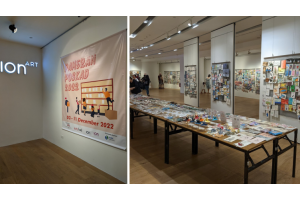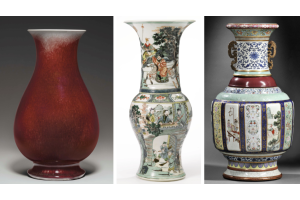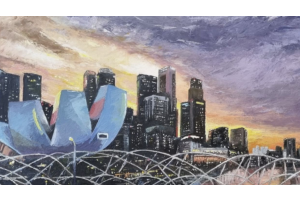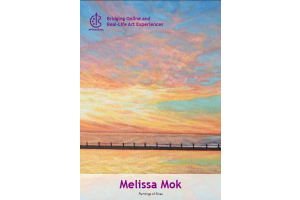Invest in Art Without Being Rich: Your Guide to Affordable Art Investments
-
June 06, 2022
Informational

Written by: Tang Kai Xian
Investing in art is often perceived as a luxury reserved for the affluent. However, this perspective is shifting as more accessible avenues open up, allowing a broader demographic to participate in art investment. This guide explores how anyone can start investing in art and the potential benefits and considerations associated with this unique asset class.
Understanding Art as an Investment
Investing in art can be a good investment with proper knowledge and strategies, especially for diversifying your portfolio and investing in something you enjoy. Art investment involves acquiring art pieces with the expectation that their value will increase over time, providing a profitable return when sold. This investment category encompasses a wide range of art, from traditional fine arts like paintings and sculptures to modern digital art and even street art.
Why invest in art
Art is a good way to diversify one’s portfolio. Apart from being a stable asset class and having better average returns than other types of investments, it is easy to forget about art’s multifaceted value. Unlike dull stock certificates, art can be displayed and enjoyed for its social and cultural value. It is evocative and a great conversation starter.
Before dipping your feet into art investments, it is prudent to take some time to mull over some of these considerations. Art is an illiquid asset. It cannot be quickly sold profitably without using the appropriate sales channels. For a better balance, your portfolio should have some liquid assets too. Also, the art transactions are rife with information asymmetry. The seller tends to have all the information about the artwork and the artist. Unless you engage an art professional, you would be none the wiser. Furthermore, if you purchase art from a gallery, you need to stomach their steep 30-60% commission rate. By choosing to shop at MeetArts, our low commission rate could help you save up to 50% of the cost allowing you to enjoy a more generous slice of the profits when your investment bears fruit.
Types of Art to Invest In

Investing in art can be both fulfilling and financially rewarding. However, choosing the right type of art to invest in requires understanding the different categories, market trends, and potential returns. Here, we explore various art forms that you might consider adding to your investment portfolio, discussing their pros and cons.
1. Fine Arts (Painting, Sculpture, Photography, etc.)
Fine Arts refer to artworks created to be appreciated for their aesthetic or intellectual content. These arts are typically classified into two categories:
- 2-dimensional works: This category includes paintings, mosaics, prints, calligraphy, and photography. These pieces are valued for their detail, historical significance, and creator's technique.
- 3-dimensional works: Comprising pottery, sculptures, and some elements of architecture and performing arts, these works are appreciated for their craft and physical presence.
ROI in Fine Arts: According to DollarSprout, art consistently delivers average returns of 7.6% per annum. Since it is unaffected by the volatility of financial markets, it is a much more stable but long-term investment.
Sometimes, the return on art can be very rewarding. In a Sotheby’s auction in 2016, Gerhard Richter — "A.B. Still," sold for almost 34 million USD. It was previously purchased in 1991 for 467,000 USD (2016 inflation-adjusted dollars). That is a whopping 7100+% increase in value over 25 years.
To put things into perspective, S&P 500 average returns are 10.67% annualized since the inception of its modern structure in 1957 while other alternative investments such as Oil (Commodity) fluctuated between 45% losses to 55% gains between 2010 and 2021.
2. Contemporary and Modern Art
Contemporary and modern art represents the artistic expressions from the late 19th century to the present day. This category is dynamic, often reflecting or challenging modern societal norms through various media such as paintings, installations, and digital art. It's a sector known for its vibrant experimentation and is often at the forefront of major art market movements.
ROI in Contemporary and Modern Arts: Contemporary and modern art can offer robust returns, especially if the artists gain popularity or their works become culturally significant over time. However, the market can be more volatile than that of older fine arts.
For example, Jean-Michel Basquiat's painting, originally sold for a modest amount in the 1980s, was auctioned for $110.5 million at Sotheby's in 2017—a stark demonstration of the potential high returns in contemporary art.
3. Digital Art and NFTs
A rapidly emerging sector in the art investment landscape, digital art utilizes digital technology as an essential part of the creative or presentation process. The rise of NFTs (Non-Fungible Tokens) has revolutionized this market by providing a way to certify ownership of digital works, making it an increasingly popular and lucrative area for investors.
ROI in Digital Art and NFTs: The market for digital art and NFTs has exploded in recent years, showing potential for high short-term returns. However, it is also highly speculative and can see significant fluctuations.
A notable example is Beeple’s digital work "Everydays: The First 5000 Days," which sold for over $69 million at Christie's in 2021. This sale highlights the lucrative, albeit risky, nature of investing in digital art.
4. Decorative Art (Ceramics, Textiles, etc.)
Decorative arts are concerned with the design and manufacture of beautiful objects that are also functional. It includes ceramics, furniture, textiles, and glassware. Often overlooked in the investment world, decorative arts can offer substantial returns, especially pieces with historical significance or created by renowned designers.
ROI in Decorative Arts: The returns on decorative arts can be modest compared to fine arts but are often more stable. Investment in decorative arts is typically a long-term strategy. Rare pieces, such as those from renowned designers or historical periods, can be significantly appreciated. For instance, a Charlotte Perriand-designed cabinet sold for over $7.5 million at an auction, far exceeding its initial price.
Each type of art investment comes with its own set of opportunities and challenges. Potential investors should consider their personal interests, market trends, and the historical performance of these art types before making decisions. Whether it's the historical depth of fine arts, the cutting-edge allure of digital art, or the practical beauty of decorative arts, the art market offers diverse options to suit various investment strategies and aesthetic tastes.
How to Start Investing in Art
Step 1: Decide on what type of art to buy
To discern and discover your taste in art, it is helpful to expose yourself to many different types of art. This could be as convenient as browsing art online. However, it may be more beneficial to view the art in person to better appreciate it. Online pictures may not capture the build up of paint by the artist's repeated strokes. Plus, one could make a more informed decision by speaking to the curator to find out more about the artwork as well as the artist. This is especially key for lesser-known emerging artists.
To verify that you are getting a fair price for the art. You should engage a reputable valuer. In general, there are several factors that make art valuable. These include, but are not limited to the context of the production of artwork (Does it have any historical significance), provenance of the art (Who owned the art previously? Its value could increase if it was owned by a famous collector, museum, etc), authenticity, etc.
Here are 2 main investment strategies based on the popularity of the artist - Speculation and Buy-and-hold. Speculation strategy tends to apply to works by emerging artists. Part of the value of art depends on the reputation of the artist. It can be explained in simple supply-demand economics. More popular the artist → Greater the demand for works by the artist → Increase in the value of the art. On the other hand, buy-and-hold approach tends to apply to works by established artists, especially deceased artists. Reduced supply of Art → Supply < Demand → Increase in the value of art.
Step 2: Buy the art
a. Online Art Marketplace
According to Statista, as of January 2022, the percentage of surveyed art buyers who cited making online art purchases in the previous 12 months increased from 44% in 2019 to 85%. Total sales of the online art and antiques market worldwide peaked at over 13 billion USD in 2021 too.
Convenience in viewing the art, making price comparisons, as well as a hassle-free and secure delivery of the art works are key determinants for the rise in popularity of the online marketplace. At MeetArts, we do just that. Artists sell directly to buyers on our platform. Buyers benefit from cost savings from our low commission rates and enjoy secured payment channels. Your money is only released to the buyer when you receive the artwork.
b. Auction House
In the first half of 2022, Fine Art auction proceeds, from around the world, reached 7.49 billion. Sotheby’s and Christie’s accounted for 38% of this fine art turnover. Both have representative offices in Singapore. In fact, on 28 August 2022, Sotheby’s held its first live auction here in 15 years which garnered 24 million SGD.
c. Art Galleries
Galleries tend to curate their art toward certain art type(s) and technique(s). Buying from an art gallery is also synonymous with quality since it has been curated. Therefore, it can be a suitable site to collect art if its collection matches your art preferences.
Its staff are also trained to provide you with more information about the painting and artists. Sometimes, exhibitions are held, expanding their collection available for sale.
d. Fractional Art Ownership
This is the most affordable option and makes art ownership more accessible. You can purchase a share of an expensive painting at a fraction of the cost and receive a share of the proceeds when the painting is sold.
Step 3: Maintain the art
Insurance. Given that art is a fragile, material asset, it is prudent to purchase coverage for your Art. They insure against instances when the art is stolen, damaged or destroyed.
Maintenance. Artwork is sensitive to environmental factors such as humidity and temperature. Wrong climates may induce cracks in sculptures and damage the ink work in paintings. Hence, there’s a need to factor in the cost of maintaining such an environment. Moreover, art is vulnerable to human factors too. Careless handling of the painting may smudge the paint and even tear the piece. Repairs on tears in paintings could cost up to five figures.
Risks and Considerations in Art Investment
Investing in art can be rewarding, but it also comes with unique risks and considerations. Understanding these risks is essential for any investor considering entering the art market. Here’s a detailed discussion of some key risks involved with art investment:
Market Volatility and Economic Impacts
- Market Sensitivity: While art can sometimes seem insulated from regular market fluctuations, it is still subject to economic downturns and shifts in consumer confidence. During economic recessions, the art market can experience significant downturns as discretionary spending declines.
- Impact of Global Events: The art market is also influenced by global events that can affect cross-border transactions and international buyer interest. For example, geopolitical tensions can restrict the movement of artworks or deter participation in international auctions.
Issues of Liquidity and Long-Term Investment
- Liquidity Concerns: Unlike stocks or bonds, art does not have a guaranteed liquidity. Selling a piece of art can take considerable time, and there is no guarantee of finding a buyer quickly. This makes art a less suitable investment for those who might need to access cash rapidly.
- Long-Term Holding: Art investments typically require a long-term perspective. The most significant appreciation in value often takes years, and investors may need to hold onto their artworks for extended periods to realize substantial gains. This long-term hold can be risky if the market for a particular type of art declines over time.
Information Asymmetry and the Importance of Professional Advice
- Knowledge Gap: The art market is characterized by information asymmetry, where sellers often have more information about the artwork than buyers. This can lead to challenges in verifying the authenticity, provenance, and true value of artworks.
- Professional Guidance: Due to the complexities and nuances of the art market, it is crucial for investors to seek advice from art professionals. Art advisors, experienced gallery owners, and auction specialists can provide insights into the quality of an artwork, its market value, and potential investment returns. They can also help navigate the legalities of art transactions, which can be intricate and varied across different jurisdictions.
- Authenticity and Provenance: The risk of forgery and disputes over ownership history is significant in the art market. Investing in due diligence by verifying the authenticity and clear provenance of artworks is essential to safeguard investments. This often requires expert evaluation and can add to the cost of investing.
Conclusion
Investing in art presents a unique and potentially lucrative opportunity for diversifying one’s investment portfolio. Whether you are drawn to the timeless elegance of fine arts, the dynamic nature of contemporary and modern art, the innovative world of digital art and NFTs, or the understated beauty of decorative arts, the art market offers a plethora of options to suit different tastes and investment strategies.
However, as with any investment, entering the art market requires careful consideration and an informed approach. The inherent risks—such as market volatility, liquidity issues, and the complexities of art valuation—necessitate a thoughtful investment strategy and often, the guidance of experienced professionals. Engaging with art advisors and leveraging their expertise can provide crucial insights into the market dynamics and help validate the authenticity and value of potential purchases.
Moreover, the art market's capacity to combine aesthetic pleasure with financial gain makes it uniquely appealing. Unlike more traditional investments, art allows investors to live with and enjoy their investments on a daily basis, enhancing their personal and social spaces while potentially increasing in value.
As you consider integrating art into your investment portfolio, remember that the key to successful art investment lies in balancing passion with prudence. By doing so, you can enjoy the dual rewards of enhancing your living environment and securing potential financial returns. Whether you're a seasoned collector or a novice, the art world welcomes you with opportunities for enrichment, education, and appreciation, making it a compelling addition to any investment portfolio.
References:
- https://dollarsprout.com/how-to-invest-in-art/
- https://seekingalpha.com/article/4502739-average-stock-market-return
- https://www.statista.com/statistics/825581/returns-on-crude-oil-investments-worldwide/
- https://www.artnews.com/art-news/market/sothebys-singapore-auction-southeastern-asian-market-1234637625/
- https://www.artprice.com/artprice-reports/global-art-market-in-h1-2022-by-artprice-com
- https://www.statista.com/statistics/273204/art-buyers-who-have-bought-art-online-2013/
- https://www.wsj.com/articles/SB10001424052748703959704575453162597091330
- https://www.businessinsider.com/famous-paintings-that-sold-for-millions-over-original-value-masterworks-2020-5#gerhard-richter-ab-still-1986-1
- https://magazine.artland.com/value-art/
- https://www.benzinga.com/money/how-to-invest-in-artwork


 PREVIOUS ARTICLE
PREVIOUS ARTICLE 







